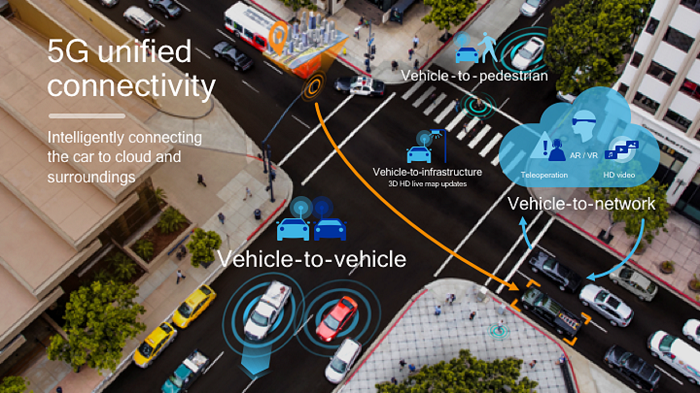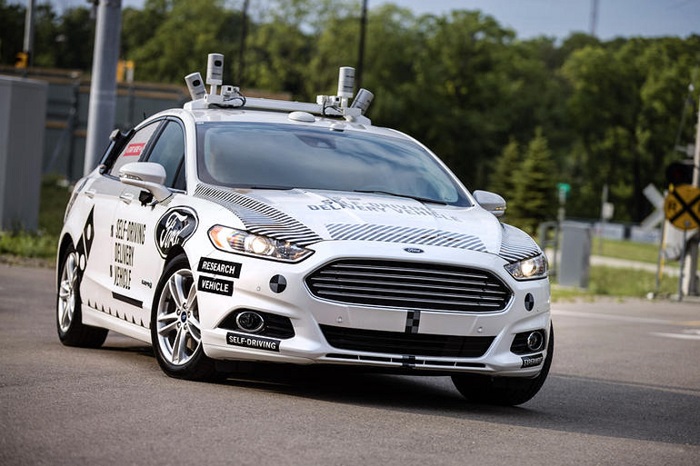By Majeed Ahmad, contributing writer
5G wireless, a global standard for mobile communications over the next decade, is making a foray into an exciting new frontier: collaboration between automotive and communication industries. The automated driving applications encompass unique connectivity requirements, and here, 5G stands out with a combination of ubiquitous coverage, millisecond latency, and geolocation services boasting accuracy in centimeters.
The 5G networking technology — along with the specialized dedicated short-range communications (DSRC) technique — is becoming a key ingredient in the connected car initiative that facilitates collaborative behaviors among cars, cyclists, and pedestrians. According to Gartner Research, there will be 250 million connected vehicles on the road by 2020.
But what’s so special about 5G in the context of the automotive world? First and foremost, it lowers latency and bolsters data speed and cellular coverage reliability — attributes that are imperative in upcoming connected cars and autonomous vehicles.
5G’s journey in the automotive world as a connectivity vehicle is embodied in the form of cellular vehicle-to-everything (C-V2X), the real-time wireless safety communication system that operates among vehicles, bicycles, pedestrians, and infrastructure. Subsequently, C-V2X’s lower latency and higher bandwidth start complementing advanced driver-assistance systems (ADAS) and self-driving vehicles.

5G networks are becoming a key enabler in advancing the use cases for autonomous cars via C-V2X connectivity mechanisms. (Image: Qualcomm)
So to navigate 5G’s journey in the automotive labyrinth, let’s begin with C-V2X communication that builds the foundation for the connected car movement. Eventually, it’s going to pave the way for self-driving cars and intelligent transportation for smart city applications.
Advent of C-V2X
C-V2X technology is based on the 3GPP Release 14 specification for PC5-based direct communication with other vehicles; roadside users such as pedestrians, cyclists, and motorcyclists; and roadside infrastructure encompassing traffic signs, construction zones, etc.
The high-speed cellular communication platform bypasses the need for a cellular network connection via a SIM card or cellular network subscription. It operates in the globally harmonized 5.9-GHz intelligent transport system (ITS) band for vehicle-to-vehicle (V2V), vehicle-to-infrastructure (V2I), and vehicle-to-pedestrian (V2P) communications.
It’s important to note that C-V2X operates in two transmission modes: direct communications and network-based communications. The PC5-based direct communication handles location, speed, and local hazards while public cellular networks operating in a mobile carrier’s licensed spectrum provide complementary services for roadside safety.
Take the example of Qualcomm’s 9150 chipset — designed to serve PC5-based direct communications — that runs the ITS stack for V2X communications and a Hardware Security Module (HSM) to boost network security via an A7 application processor operating at 1.5 GHz.

Danlaw’s AutoLink on-board unit (OBU) and RouteLink roadside unit (RSU) are based on Qualcomm’s 9150 chipset for C-V2X communications. (Image: Danlaw)
The 9150 chipset also comes integrated with Global Navigation Satellite System (GNSS) capability that facilitates GPS time along with position and velocity information for high-precision location services. Qualcomm’s dead-reckoning software complements it with accurate positioning and time information in the most challenging environments.
The 9150 chipset’s design wins are a testament that C-V2X technology is now gaining momentum. For instance, RF chipmaker Qorvo has specifically designed the QPF1002Q front-end module (FEM) to pair with Qualcomm’s 9150 chipset. Here, it’s important to mention that intelligent, on-board systems in connected car and autonomous driving designs mandate higher levels of precision in RF communication with other vehicles, infrastructure, and even handsets.
Qorvo’s RF module includes an HBT power amplifier (PA), PHEMT low-noise amplifier (LNA), and PHEMT switch. Moreover, the combination of an RF front-end and a C-V2X chipset has been under trials, and participants include carmakers like Audi, Ford, Nissan, and PSA.
Likewise, Quectel Wireless Solutions has incorporated the 9150 chipset in its AG15 module, targeted at telematics and V2X applications for road safety and autonomous driving. It enables low latency with highly dense data exchange between vehicles and their surroundings. The information sharing among road users, in turn, avoids traffic congestions and prevents collisions.
The module features a multi-constellation receiver with coverage from GNSS, GPS, GLONASS, BeiDou, Galileo, and QZSS satellites. It integrates satellite-based augmentation systems (SBAS) and Qualcomm’s 3D dead-reckoning technology to enhance positioning accuracy and speed.
V2X augments self-driving
The progression of C-V2X communication is intrinsically tied to how 5G can serve autonomous car projects. Qualcomm’s 9150 chipset is a case in point: It provides additional inputs about the vehicle’s surroundings for ADAS, sensors, cameras, radar, and LiDAR.
For example, the C-V2X chipset, which Qualcomm launched in 2017, provides non-line-of-sight (NLOS) sensing capability to support high-speed mobility and high-vehicular-density deployments and thus paves the way for safe autonomous driving.
In other words, the ability of C-V2X technology to provide information about the vehicle’s surroundings and identify objects is a key enabler in the carmaker’s quest for safety-conscious automated-driving solutions.
Take, for instance, LiDAR scanners, which operate across a radius of only a few tens of meters. Here, the ubiquitous cellular coverage is far more likely to serve LiDAR than short-range communication mechanisms like DSRC connectivity.

Qualcomm has joined hands with AT&T, Ford, and Nokia to carry out autonomous vehicle trials based on C-V2X technology. (Image: Ford)
Savari, which has optimized its V2X software stack for Qualcomm’s 9150 C-V2X chipset, has recently demonstrated self-driving with obstructed or no-visibility scenarios in Audi and Ford vehicles in Washington, D.C. The trial involved pedestrians and vulnerable road users, and it sent alerts to other vehicles about emergency electronic brake light activation and communication with traffic-signal controllers.
The 5G New Radio (NR) standard provides a unified connectivity fabric to expand into new industries. And ADAS sensor technologies, as well as autonomous vehicles, are going to be the major beneficiaries of 5G’s high throughput to build dynamic maps based on camera and sensor data and then distribute them at street intersections.
The low-latency and ultra-reliable 5G communication links are also going to be crucial in facilitating the level of predictability needed for advanced path planning for autonomous driving. For instance, perception sharing of high throughput sensor data helps create real-world models and thus enables path-planning intention and trajectory sharing for faster and safer maneuvers.
5G in the smart city
The fact that C-V2X has a clear and forward compatible evolution path to 5G NR is also culminating into an ambitious crossover between the automobile and transportation sectors. The ability of C-V2X to provide enhanced range and reliability for direct communication without network assistance is critical in smart cities’ quest for coordinated driving and real-time local updates.
The C-V2X trial carried out in Las Vegas in early 2019 is a good example. Qualcomm, the supplier of the 9150 C-V2X chipset, joined hands with the city of Las Vegas, Regional Transportation Commission of Southern Nevada, and Commsignia, the supplier of RSUs, to demonstrate C-V2X use cases.
Commsignia’s RSUs were placed at nearly 100 intersections throughout the city, along with vehicles equipped with the company’s C-V2X aftermarket OBUs, to demonstrate connected cars in public.
The smart city trials are in progress, and so is 5G’s ability to reshape connected car, autonomous driving, and intelligent transportation initiatives with enhanced range and reliability. Exciting times are ahead.
Advertisement
Learn more about Electronic Products Magazine








